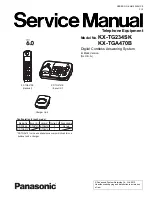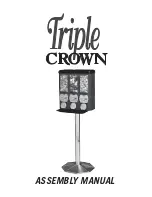
7.6.7. DIGITAL BOARD SECTION
When the unit fails to boot up the system, take the troubleshooting procedures very carefully. It may have a serious problem.
The symptom: No response when the power is turned on. (No LCD display, and keys are not accepted.)
The first step is to check the power source. If there is no problem with the power supply unit, the problem may lie in the digital
unit (main board).
As there are many potential causes in this case (ASIC, DRAM, etc.), it may be difficult to specify what you should check first.
If a mistake is made in the order of checks, a normal part may be determined faulty, wasting both time and money.
Although the tendency is to regard the problem as a serious one (IC malfunction, etc.), usually most cases are caused by solder
faults (poor contact due to a tunnel in the solder, signal short circuit due to solder waste).
Note:
1. Electrical continuity may have existed at the factory check, but a faulty contact occurred as a result of vibration, etc., during
transport.
2. Solder waste remaining on the board may get caught under the IC during transport, causing a short circuit.
Before we begin mass production, several hundred trial units are produced at the plant, various tests are applied and any
malfunctions are analyzed. (In past experiences, digital IC (especially DRAM and FLASH ROM) malfunctions are extremely rare
after installation in the product.)
This may be repaired by replacing the IC, (DRAM etc.). However, the real cause may not have been an IC malfunction but a
soldering fault instead.
Soldering faults difficult to detect with the naked eye are common, particularly for ASIC and RA (Resistor Array). But if you have
an oscilloscope, you can easily determine the problem site or IC malfunction by checking the main signal lines.
Even if you don’t have such a measuring instrument, by checking each main signal line and resoldering it, in many cases the
problem will be resolved.
An explanation of the main signals (for booting up the unit) is presented below.
Don’t replace ICs or stop repairing until checking the signal lines.
An IC malfunction rarely occurs. (By understanding the necessary signals for booting up the unit, the “Not Boot up”
display is not a serious problem.)
What are the main signals for booting up the unit?
The ASIC (IC501) controls all the other digital ICs. When the power is turned on, the ASIC retrieves the operation code stored
in the FLASH ROM (IC523), then follows the instructions for controlling each IC. All ICs have some inner registers that are
assigned to a certain address.
It is the address bus by which the ASIC designates the location inside each IC. And the data bus reads or writes the data in
order to transmit the instructions from the ASIC to the ICs.
These signal lines are all controlled by voltages of 3.3V (H) or 0V (L).
Between the DRAM (IC503), Gate Array IC (IC520) signal lines are controlled by voltages of 5V (H) or 0V (L).
97
KX-FHD333BR
Summary of Contents for KX-FHD333BR
Page 3: ...1 TRANSLATION LISTS 1 1 LCD MESSAGES 3 KX FHD333BR ...
Page 4: ...1 2 ERROR CODE 1 3 BUTTON LISTS 4 KX FHD333BR ...
Page 21: ...5 1 2 COMPONENT LOCATIONS 21 KX FHD333BR ...
Page 33: ...6 2 2 HOW TO REMOVE THE OPERATION PANEL BLOCK 33 KX FHD333BR ...
Page 34: ...6 2 3 HOW TO REMOVE THE OPERATION BOARD AND LCD 34 KX FHD333BR ...
Page 35: ...6 2 4 HOW TO REMOVE THE IMAGE SENSOR CIS 35 KX FHD333BR ...
Page 36: ...6 2 5 HOW TO REMOVE THE THERMAL HEAD 36 KX FHD333BR ...
Page 37: ...6 2 6 HOW TO REMOVE THE PLATEN ROLLER AND BACK COVER 37 KX FHD333BR ...
Page 38: ...6 2 7 HOW TO REMOVE THE PICKUP ROLLER 38 KX FHD333BR ...
Page 39: ...6 2 8 HOW TO REMOVE THE CASSETTE LEVER 39 KX FHD333BR ...
Page 40: ...6 2 9 HOW TO REMOVE THE BOTTOM FRAME 40 KX FHD333BR ...
Page 42: ...6 2 11 HOW TO REMOVE THE MOTOR BLOCK AND SEPARATION ROLLER 42 KX FHD333BR ...
Page 43: ...6 2 12 HOW TO REMOVE THE GEARS OF MOTOR BLOCK 43 KX FHD333BR ...
Page 44: ...6 3 INSTALLATION POSITION OF THE LEAD WIRES 44 KX FHD333BR ...
Page 57: ...7 5 2 SREVICE MODE SETTINGS Note The above values are the default values 57 KX FHD333BR ...
Page 71: ...71 KX FHD333BR ...
Page 85: ...85 KX FHD333BR ...
Page 86: ...CROSS REFERENCE TEST FUNCTIONS P 50 86 KX FHD333BR ...
Page 87: ...CROSS REFERENCE TEST FUNCTIONS P 50 87 KX FHD333BR ...
Page 88: ...CROSS REFERENCE TEST FUNCTIONS P 50 88 KX FHD333BR ...
Page 89: ...CROSS REFERENCE TEST FUNCTIONS P 50 89 KX FHD333BR ...
Page 90: ...90 KX FHD333BR ...
Page 91: ...91 KX FHD333BR ...
Page 92: ...CROSS REFERENCE TEST FUNCTIONS P 50 92 KX FHD333BR ...
Page 96: ...96 KX FHD333BR ...
Page 100: ...I O and Pin No Diagram 100 KX FHD333BR ...
Page 104: ...7 6 7 3 NG EXAMPLE 104 KX FHD333BR ...
Page 109: ...7 6 9 2 TROUBLESHOOTING FLOW CHART 109 KX FHD333BR ...
Page 115: ...7 6 13 THERMAL HEAD SECTION Refer to THERMAL HEAD P 129 115 KX FHD333BR ...
Page 116: ...8 CIRCUIT OPERATIONS 8 1 CONNECTION DIAGRAM 116 KX FHD333BR ...
Page 118: ...8 2 1 GENERAL BLOCK DIAGRAM 118 KX FHD333BR ...
Page 120: ...8 3 2 MEMORY MAP 120 KX FHD333BR ...
Page 128: ...8 4 2 BLOCK DIAGRAM 128 KX FHD333BR ...
Page 131: ...TIMING CHART i Print Duty 50 or less ii Print Duty more than 50 131 KX FHD333BR ...
Page 150: ...150 KX FHD333BR ...
Page 162: ...9 3 TEST CHART 9 3 1 ITU T No 1 TEST CHART 162 KX FHD333BR ...
Page 163: ...9 3 2 ITU T No 2 TEST CHART 163 KX FHD333BR ...
Page 164: ...10 FIXTURES AND TOOLS 164 KX FHD333BR ...
Page 165: ...11 CABINET MECHANICAL AND ELECTRICAL PARTS LOCATION 11 1 GENERAL SECTION 165 KX FHD333BR ...
Page 166: ...11 2 OPERATION PANEL SECTION 166 KX FHD333BR ...
Page 167: ...11 3 BACK COVER SECTION 167 KX FHD333BR ...
Page 168: ...168 KX FHD333BR ...
Page 169: ...11 4 UPPER CABINET SECTION 169 KX FHD333BR ...
Page 170: ...11 5 LOWER CABINET P C BOARD SECTION CROSS REFERENCE MOTOR SECTION P 171 170 KX FHD333BR ...
Page 171: ...11 6 MOTOR SECTION 11 7 ACTUAL SIZE OF SCREWS 171 KX FHD333BR ...
Page 172: ...12 ACCESSORIES AND PACKING MATERIALS 172 KX FHD333BR ...
















































